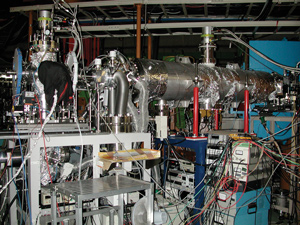Jun. 13, 2014 Research Highlight Physics / Astronomy
Measuring a magnetic halo
Precise data on the magnetic interaction between the nucleus and electrons in beryllium-11 could help to pin down its unusual nuclear shape
 Figure 1: The prototype slow radioactive nuclear ion beam facility (SLOWRI) can create, cool and trap ions of short-lived ions such as beryllium-11. © 2014 Michiharu Wada, RIKEN Nishina Center for Accelerator-Based Science
Figure 1: The prototype slow radioactive nuclear ion beam facility (SLOWRI) can create, cool and trap ions of short-lived ions such as beryllium-11. © 2014 Michiharu Wada, RIKEN Nishina Center for Accelerator-Based Science
Atomic nuclei come in a range of shapes and sizes, from spherical to pear-shaped, and many behave as if they were blobs of an incompressible fluid. A few nuclei are different—beryllium-11, for example, has an inner core of protons and neutrons with an outer ‘halo’ neutron, which makes the effective nuclear radius of this isotope much larger than predicted by simple models.
A team led by Michiharu Wada at the RIKEN Nishina Center for Accelerator-Based Science has now made some high-precision measurements that could help determine the magnetic radius of the beryllium-11 nucleus1.
The characteristic spectrum of light frequencies absorbed and emitted by an atom is shaped by electromagnetic interactions between its nucleus and electrons. Each frequency can consist of a double signal, known as a splitting or hyperfine structure, stemming from the way that the electron energies are populated. The gap between these hyperfine energy levels is influenced by the magnetization distribution of the nucleus—a phenomenon called the Bohr–Weisskopf effect. “The magnetization of beryllium-11 is mainly carried by the single halo neutron,” says Wada. “If the halo neutron has an extended distribution, the Bohr–Weisskopf effect should be large.”
Using the prototype slow radioactive nuclear ion beam facility (SLOWRI) (Fig. 1), the researchers bombarded a beryllium-9 target with a beam of carbon-13 atoms to create high-energy beryllium-11 ions. These were cooled and trapped in batches of about 110 ions, which have a half-life of less than 14 seconds.
The team then irradiated the trapped beryllium-11 ions with laser light at a slightly lower energy than the ions’ resonant wavelength, which caused them to emit millions of photons per second, and then cooled them to temperatures very near absolute zero. Exposure to microwave radiation then induced transitions between different hyperfine energy levels, drastically changing the intensity of the observed fluorescence. From this change, the researchers could determine the hyperfine transition energy.
The data yielded the most precise measurements obtained to date for the magnetic hyperfine structure constant for beryllium-11. This constant quantifies the interaction energy between the nuclear magnetization and the electrons. To calculate the Bohr–Weisskopf effect itself, Wada’s team now needs to measure the magnetic moment of the nucleus with comparable precision.
“We tested such measurements for stable beryllium-9 isotopes many years ago, but experiments on unstable isotopes such as beryllium-11 are totally different,” says Wada. Further work on SLOWRI will enable the precision spectroscopy needed to make the crucial measurements on beryllium-11 and many other nuclei.
References
- 1. Takamine, A., Wada, M., Okada, K., Sonoda, T., Schury, P., Nakamura, T., Kanai, Y., Kubo, T., Katayama, I., Ohtani, S. et al. Hyperfine structure constant of the neutron halo nucleus11Be+. Physical Review Letters 112, 162502 (2014). doi: 10.1103/PhysRevLett.112.162502
